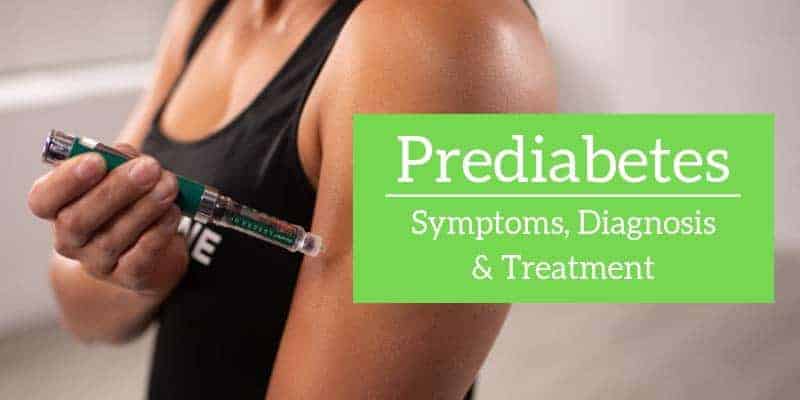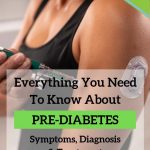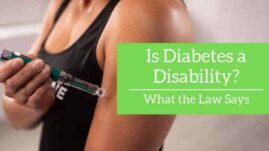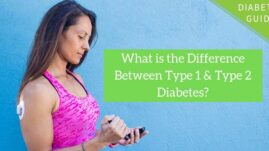The day you’re diagnosed with prediabetes can feel like a remarkably scary day. It can also be a day that motivates you to take action. While type 2 diabetes is a progressive disease (more on that later), there are still many things you can do to improve your blood sugars right away.
In fact, prediabetes is type 2 diabetes in its earliest stages — which is why it shouldn’t be dismissed or taken lightly. You’ve earned the “pre” in front of “diabetes” because while your blood sugar levels are higher than normal, they simply aren’t high enough to qualify for full-fledged type 2 diabetes.
For some, prediabetes and type 2 diabetes is “reversible.” For others, it may not be.
In this article, we’ll look at the symptoms of prediabetes, how it’s diagnosed, how it’s treated, and whether or not it can be “reversed.”

Table of Contents
Symptoms of prediabetes
The trickiest part of prediabetes is that the symptoms can be very subtle and easy to ignore for years — until blood sugar levels are high enough to catch your attention.
The surest way to catch prediabetes in its tracks is by scheduling annual check-ups with your primary care doctor and requesting that your HbA1c level be tested. More on A1c’s later….
Like type 2 diabetes, the symptoms of prediabetes are the result of gradually increasing blood sugar levels, insulin resistance, and inadequate levels of insulin.
The most common prediabetes symptoms are:
- increased thirst
- increased hunger
- frequent urination
- dry mouth
- headaches
- feeling tired after meals
- inexplicable weight-gain or weight-loss
- blurry vision
The Centers for Disease Prevention and Control (CDC) report that as few as 10 percent of people with prediabetes are actually aware of their increasing symptoms.
The CDC also estimates that 84 million American — 1 out of every 3 people — has prediabetes, most of whom don’t know it.
Diagnosing prediabetes
The American Diabetes Association qualifies a diagnosis of prediabetes based on your HbA1c and your “fasting” blood sugar level (when you first wake up in the morning) and 2 hours after eating a meal:
- HbA1c: 5.7 to 6.4 percent
- Fasting blood sugar: 100 to 125 mg/dL
- 2 hours after a meal: 140 mg/dL to 199 mg/dL
You can compare those numbers to the blood sugar levels in a non-diabetic:
- Fasting blood sugar (in the morning, before eating): 70 to 90 mg/dL
- 1 hour after a meal: 90 to 130 mg/dL
- 2 hours after a meal: 90 to 110 mg/dL
- 5 or more hours after eating: 70 to 90 mg/dL
Diagnosing prediabetes or type 2 diabetes is actually fairly straightforward, but the problem is that both you and your doctor may not see an A1c or blood sugar level in the “prediabetes” zone as the red flag that it truly is.
This is diabetes. It’s just the earlier stages of the disease. You should take action. You should treat it with as much concern as you would if it was diagnosed as “type 2 diabetes.”
To be tested for prediabetes or type 2 diabetes, you’ll need to schedule a check-up with your primary care doctor and ask for these two blood tests: your fasting blood sugar and your HbA1c.
What is your fasting blood sugar?
Simply put, your fasting blood sugar is your blood sugar first thing in the morning before you eat breakfast. Since it typically has been more than 8 hours since your last meal, the fasting blood sugar indicates how your body has managed its blood sugar levels when variables like food are not present.
What is the HbA1c test?
Your HbA1c — also known as A1c — is a blood test that measures the amount of “leftover” glucose (also known as “advance glycogenated end-products or “AGEs”) that have accumulated in your bloodstream during the prior 3 months. The higher your A1c is, the more damage occurs to your body’s nerve endings and blood vessels in areas like your eyes, fingers, toes, and your kidneys.
The more AGEs are present in your blood, the more damage occurs that can develop into diabetes complications like:
- retinopathy
- neuropathy
- hair loss
- gastroparesis
- dermopathy
- nephropathy.
The higher your blood sugars are each day, the higher your next A1c result will be!
Factors that increase your risk of prediabetes
While mainstream media often depicts type 2 diabetes as the result of being overweight, not exercising, and eating unhealthy food, it is significantly more complex.
There are actually two pathways that lead to prediabetes and type 2 diabetes.
The first is basic insulin resistance, which means your body needs more and more insulin to maintain healthy blood sugar levels. At a certain point, the pancreas can’t keep up with the demand, and blood sugars begin to rise.
The second is a genetic disposition that results in the gradual dysfunction and destruction of your pancreas’ beta-cells. Beta-cells play the leading role in insulin production, and many people with type 2 diabetes struggle to produce normal amounts of insulin.
Determining which group you are in isn’t easy, or even possible for the average patient.
For patients in this second group, “reversing” diabetes isn’t likely possible, but that doesn’t mean you can’t take steps towards improving your health isn’t worthwhile.
The most important factors that increase your risk of prediabetes are:
- If you are overweight
- If you are age 45 years or older
- If you have a parent or sibling with type 2 diabetes
- If you exercise less than 3 times a week
- If you had gestational diabetes during pregnancy
- If you gave birth to a baby that weighed over 9 pounds
- If you are African American, Hispanic/Latino American, American Indian, Pacific Islander, or Asian American. These ethnicities have all shown a higher risk of developing type 2 diabetes.
How to reduce your risk of prediabetes & type 2 diabetes
Whether your diabetes is the result of insulin resistance or genetic beta-cell dysfunction, there are still many things you can do to improve your body’s sensitivity to insulin and prevent or delay the further progression of the condition.
Get moving
The more you exercise, the more calories and glucose your body burns over 24 hours, and the more it burns even afterward when you’re at rest.
Even going for a 15-minute walk every day at lunch is a worthwhile start. Walking is often dismissed as not being intense enough to provide many benefits, but walking is a great way to burn fat and calories without increasing your appetite. It’s also very easy on the joints, can be done on a treadmill or outside, and you can set your own comfortable pace.
The next time you come home from work and think, “I’m too tired to exercise,” stop that pattern of thinking and commit to just 15 minutes of movement.
Make changes to your diet
Eating a healthier diet doesn’t mean you have to cut out all the things you love. Even making changes to one or two meals a day can have benefits.
For example, maybe you start eating a very green salad loaded with fresh veggies for lunch instead of that footlong sub-sandwich. Or perhaps you start limiting your soda consumption to one can per day instead of 4 cans per day.
Pick a couple of places to make changes so it isn’t quite so overwhelming. Over time, you may find that you want to keep making improvements to other food choices, too. And remember, the goal doesn’t have to be 100 percent perfection. The “80/20 Rule” is great: choosing healthy, real food 80 percent of the time, with 20 percent left for less-than-perfect treats.
“Learning moderation instead of deprivation was the hardest for me. At first, I would deprive myself of things I loved to eat because I thought that would be a quick fix. Just like any diet, it wasn’t sustainable. I learned that balancing what I wanted in moderation worked well and was much easier to maintain long-term.”
Venus Jones (read Venus’ story of reversing prediabetes)
Get more sleep
Getting too little sleep has been linked directly to a variety of issues that impact your blood sugars, hunger levels, weight gain, mood, and cravings.
A lack of sleep — especially a consistent lack of sleep — can take a tremendous toll on your insulin sensitivity, too, which means you’ll need more insulin to regulate your blood sugars than normal. This can easily lead to weight gain, reduced energy, and higher blood sugars over time.
There’s no way around it — your body needs more sleep. Start improving your own sleep habits by setting an alarm or reminder in the evening to ding when you need to begin getting ready for bed.
Lose weight
Easier said than done, certainly, but all of the aforementioned steps toward reducing your risk of diabetes should also help you lose weight.
Extra body fat, quite simply, increases your body’s resistance to insulin. The more extra body fat you have, the more insulin it will take to help your body achieve healthy blood sugar levels. Losing weight also decreases inflammation levels, which decreases insulin resistance, too.
*Do keep in mind: for some, losing weight may be challenging if your diabetes has progressed to type 2 diabetes already, and blood sugars are already significantly elevated. Talk to your doctor about medications that will help bring your blood sugars down while you continue to work on your weight-loss goals.
Quit smoking. Nicotine has been proven in research to make insulin less effective. This means, as a smoker, you’re creating higher levels of insulin resistance even if you’re doing other healthy things like exercising and eating a healthy diet.
Smoking increases your risk of diabetes by 30 to 40 percent. Quit smoking and instantly increase your insulin sensitivity, thus improving your blood sugars without making any other changes.
Can prediabetes be reversed?
For some, prediabetes is reversible if it is the “simple” result of weight gain and unhealthy habits. For many, however, prediabetes is the result of the body’s gradual destruction of beta-cells.
Beta-cells play a critical role in insulin production. More and more research today regarding type 2 diabetes demonstrates that approximately 60 percent of people with type 2 diabetes are experiencing a lack of insulin production through “beta cell dysfunction and destruction.”
“It is now well recognized that 2 factors are involved: impaired [beta-cell] function and insulin resistance,” explains John E. Gerich, MD, in a study published by the Mayo Clinic Proceedings. “Prospective studies of high-risk populations have shown insulin-resistance and/or insulin-secretory defects before the onset of impaired glucose tolerance.”
This means that while you should absolutely still pursue healthier habits around nutrition, exercise, weight loss, sleep, and quitting smoking, the gradual progression of your disease means your diagnosis is here to stay.
That being said, making any changes you can in your habits can play a tremendous role in whether or not you need to start taking diabetes medications or if you need to start insulin injections to help bring your blood sugars down to a healthy level.
Read more on “reversing” diabetes: Is Type 2 Diabetes Reversible?
Living well as a person facing a diagnosis of prediabetes or type 2 diabetes is very possible. The first step is to take action and do whatever is in your power to improve your body’s sensitivity to insulin, improve your diet, get more exercise, get more sleep, and say goodbye to detrimental habits like smoking.
Prediabetes is diabetes. The sooner you take action, the sooner you improve your health.





Peter
Questions:
1)as a pre diabetic 5.8 a1c
I would like to know if there is a table for ranges for a pre diabetic to follow. Example
A)how high a pre diabetic should aim on a post meal after 1 hour and 2 hour
B)before working out with weight, a pre diabetic should have a blood glucose of (#)?
C)should a pre diabetic, as soon as the workout with weights is finished . Should we replenish the glucose by intake of some carbs , and if so how much carbs, example 5 grams or 20 grams ?. Or a glucose number we shouldn aim or only have protein with fat and no carbs at all?.
D)should a pre diabetic before working out with weights, should the pre meal be with carbs if so how much or blood glucose level to aim to have a well plan workout.
Christel Oerum
I don’t know if there are that precise guidelines for prediabetes. This is a link to our prediabetes resources https://diabetesstrong.com/category/diabetes/prediabetes/
Najeeb Safi
Thanks for posting such a great article. I was diagnosed in 2017 as a pre-diabetes. My Ac1 was 5.9. Then i worked so hard to keep it under 5.6. However later on i was diagnosed by fibromyalgia, and I am not able to exercise properly. Now my AC1 is 5.8 . If there is any post or link related to fibromyalgia please share it with us.
Thank
Christel Oerum
We have one post about fibromyalgia that you can find here: https://diabetesstrong.com/diabetic-and-fibromyalgia-staying-active-without-triggering-a-massive-flare-up/ Ginger is a great resource when it comes to fibromyalgia and diabetes
CazT
Thanks for the article. After 2 years of being prediabetic and making no improvement in my numbers despite being very lean and active and changing my diet radically to a very low carb one, I had come to the conclusion that this must be the consequence of beta cell malfunction yet this is the first article I have found (apart from some scientific studies) that has acknowledged this possibility. In the various diabetes forums where I have asked questions, I am invariably told to make sure I’m counting carbs properly (I am), that I might be ‘TOFI’ – thin on the outside, fat on the inside (highly unlikely with a BMI of 18.3) and basically made to feel that it’s something I’m not doing properly when I’ve done my utmost to address the issue and read very widely about it all. It does rather sound from what you say that I’ll either stay prediabetic to my dying day or eventually succumb to diabetes. I’ve wondered about asking to go onto metformin, just to lower the numbers a bit and allow me a bit of leeway with my diet but am reluctant to go onto medication if I can avoid getting my numbers higher. My last A1c was 47 mmol/mol, though, having been 43 two years ago, so it looks dubious. Thanks again – it’s a relief to know that beta cell reduction is a real possibility in my case.
Christel Oerum
I’m glad you found this article and it could help explain what might be going on. An A1c of 47 if fairly low so your doctor might not want to prescribe you any meds. I would recommend having an autoantibody test done, just to verify the type of diabetes you live with (more on that here).
Hang in there and continue doing what you’re doing. Remember, you’re doing everything in your power sometimes that’s just not enough to keep blood sugars in range
CazT
Thank you very much for your reply. I did have an antibodies test, and a CT scan of the pancreas, and they came back negative/normal so I’m assuming I’m on track for T2. I’d really like to find a way to boost beta cells and have been researching a lot into that. I’m wondering about losing even more weight just to test out the fatty liver theory further but I’m pretty skinny and it seems unlikely that taking BMI to below 18 would be very wise; in fact when I contacted Roy Taylor, who has done a lot of research in this area, he thought the same.
Lana
How can I have a 102 glucose fasting result and a 5.6 a1c
Christel Oerum
A1c is an average of your blood sugars over the last 3 months. That includes not just your fasting blood sugars, so your blood sugar is most likely running higher at other time
Ruthie Bennett
I have been a predibetic for the past 3 months alc 5.9 dose tht mean diabetes
Christel Oerum
Your doctor will usually look at your A1c over time but also your fasting blood sugar and blood sugar after meals. Regardless of the diagnosis, you can still start taking some of the actions in this article to help reduce the risk of developing type 2 diabetes.
Julia
Thank you for this article! Will be taking your advice. Question: do all 3 of the numbers (A1C, fasting, after eating) have to be off to be considered preD? Or just 1 off number is considered preD? I have an appt in 3 weeks but in the mean time am panicking! Also, how long with all 3 numbers being in normal range would be considered reversed?
Ginger Vieira
Hi Julia!
First of all: don’t panic. Take a deep breath. I know the potential of a diabetes diagnosis is very overwhelming and scary, but you are not alone in this. And there are so many things you can do to manage, thrive with, and potentially reverse the condition.
Secondly, as far as it’s implied by the ADA, yes, all three of those details need to be high to qualify for prediabetes, which means to consider it “reversed,” all 3 of those numbers would need to be in a healthy range.
I want to make sure you understand though that all three of those numbers are directly linked to each other. It’s very unlikely, for example, that your A1c would go down if your fasting blood sugar and 2-hour post-meal blood sugar didn’t also go down. These numbers are all measuring the same thing: your blood sugar at different points of the day.
Fasting: your morning BG
2-hours post-meal: how your body handles BG after a meal
A1c: how your body is handling your BGs overall, every day
The length of time that qualifies for remission varies depending on who you ask — DiaTribe has a great article on this: https://diatribe.org/type-2-diabetes-remission-what-it-and-how-can-it-be-done.
Between now and your appointment in 3 weeks, maybe one thing you could do is to simply continue reading and studying, without pressure, shame, or fear. Just learn as much as you can so you’re fully prepared when you go to that appointment.
Reema
Hello .. I am just curious to know whether I am diabetic or pre diabetic.
My A1c is 7.0 but my fasting sugar is between 115-124 most of the days. My post meal sugar is between 150-180.
I am not on any medications currently and do not have any symptoms of diabetes mentioned in above article.
Christel Oerum
Diabetes is what we call a “silent” disease since you can’t always feel how much havoc it’s doing to your body. Your doctor will have to evaluate if you should be on medication. Regardless I highly recommend you start taking action to lower your average blood sugars
Carol Maish
I am diagnosed as prediabetic and am trying to bring down my glucose numbers. My fasting glucose is always higher than the numbers I get during the day, an hour or two after eating, why? How can I get a lower fasting number?
Christel Oerum
There are a few things you can do. Increase your movement/exercise amount, reduce carbs at night and if needed reduce your body fat percentage. I think this article will be helpful for you: https://diabetesstrong.com/how-to-lower-your-a1c/
Carol Maish
Thank you for your suggestions; I’ll give those a try. I know I need to introduce more walking into my health routine.
Louise Laba
I get a blood test every six month for a number of reason with the medication I am on. My fasting blood sugar keeps rising from 200 to 217 this last time. My dr. does not seem concerned but my diabetic friends do. . My friends say it might have something to do with the fact I am always so tired and thirsty. I have gained 35 lbs over the last couple of years and I am 65. Should I be concerned? Thank you for any input.
Christel Oerum
With fasting blood sugars at that level I would expect your doctor to run more tests to see if there is a reason for concern. You can tell your doctor that you’d like to have a Hemoglobin A1C test done (that reflects your average blood sugar over the last 3 months) and ask why he/she isn’t concerned. If your doctor isn’t willing to have that discussion with you I would suggest finding another doctor.
It might be nothing, but until you get tested, you don’t know..
Virginia Busch
Good morning. I’ve been diagnosed with pre-diabetes and in my research to figure out how to reverse, I’ve come across your site. What great, clear, informative information. I was wondering if you could recommend any books which are not all scientific that give meal plans, recipes, and how to lose weight. I’m a 68 year old female. Weight loss is difficult. Although I’ve lost 22 pounds in the last seven months. I just starting using a recumbent bike (runner’s knees and arthritis). Any insight you can provide would be most appreciated! In advance, my thanks!
Christel Oerum
I’m glad you found that article useful. There are many weight loss gurus out there, but in a nutshell weight loss comes down to being in a calorie deficit. A calorie deficit means that you burn more calories than you consume. For free resources I’d recommend you start by looking at the following articles:
1. How to calculate your calories: https://diabetesstrong.com/how-to-find-your-daily-calorie-need/
2. Meal plans: https://diabetesstrong.com/category/nutrition/meal-plans/
If you already now know how many calories you consume you can use that as your baseline rather than the calculator and reduce your calories from there or add more activity
Libby F Fife
Hi There,
Thank you for the article. I did have a question about the glucose level chart for people without pre diabetes/diabetes.
You can compare those numbers to the blood sugar levels in a non-diabetic:
Fasting blood sugar (in the morning, before eating): 70 to 90 mg/dL
1 hour after a meal: 90 to 130 mg/dL
2 hours after a meal: 90 to 110 mg/dL
5 or more hours after eating: 70 to 90 mg/dL
Could you please tell me the source of those numbers, possibly with a link to the specific page? I wasn’t able to cull all of that information from the American Diabetes link provided. It seems to be a little different from the Joslin and ACCE sites as well. I’d like to take the source info to my doctor when I see her in April.
Thanks so much in advance for any help. I certainly appreciate the info. on the site-it honestly is helpful.
Thanks,
Libby Fife
Ginger Vieira
Hi Libby!
First of all, you’re right — the numbers don’t match exactly, as I rounded 126 up to 130. The inconsistency comes from the translation of the numbers the ADA provides vs. the A1C rates they provide. For example, if you translate a 6.4 A1c like they have listed for prediabetes diagnosis, it translates to 137 mg/dL, not 126. So there’s some wiggle room with all of this data. I chose a middle ground of 130 mg/dL for somewhere between their glucose level versus their listed A1c level.
That being said, the difference between 126 and 130 on a glucometer is nil because there’s a 15% inaccuracy range with every FDA-approved glucometer. You could test now and again 30 seconds later and get a slightly different result like 130 and 126. I hope that helps at your next doctor’s appointment!
Thanks for catching the inconsistencies in our reference vs. the numbers listed.
Libby F Fife
Thanks Ginger! That all makes total sense to me. It’s hard to sort out different sets of numbers isn’t it? When I go to the doctor in April though I will have your information in mind and integrate it with what the doctor says. Thank you again for your help!
Libby